Cabbage, a common vegetable found in many kitchens, has been a staple in our diets for centuries. But did you know that beyond its culinary uses, cabbage has been traditionally used for its medicinal properties? This article delves deep into the world of cabbage bandages, a lesser-known remedy for treating inflammation and joint pain. As you navigate through this comprehensive guide, you’ll discover the science behind cabbage’s anti-inflammatory properties, learn how to prepare and use cabbage bandages, and gain insights from experts in the field. Whether you’re a health enthusiast, a professional in the medical field, or someone simply curious about natural remedies, this article promises to provide valuable information that could change the way you perceive this humble vegetable.
Cabbage Bandages for Treating Inflammation and Joint Pain
What you’ll learn:
- The historical and cultural significance of cabbage as a medicinal remedy.
- The science-backed reasons why cabbage can help reduce inflammation and alleviate joint pain.
- Step-by-step instructions on how to prepare and apply cabbage bandages.
- Expert opinions and testimonials on the efficacy of this natural remedy.
Table of Contents
- Historical Background of Cabbage as a Remedy
- Scientific Basis for Cabbage’s Anti-inflammatory Properties
- Preparing Cabbage Bandages
- How to Apply Cabbage Bandages
- Expert Opinions and Testimonials
- Frequently Asked Questions
- Final Thoughts
- Sources
Historical Background of Cabbage as a Remedy
Cabbage, a member of the Brassica family, has been cultivated for thousands of years. Its origins can be traced back to Europe before 1000 BC. The use of cabbage as a remedy and a food source has a rich history documented since antiquity. It was considered a luxury on Roman tables and by the Middle Ages had become a significant part of European cuisine.
The medicinal properties of cabbage were well-regarded by the Greeks and Romans, who used it for a variety of ailments such as gout and headaches. The Romans, in particular, had a variety of cabbage, including Pompeii cabbage, which was known for its tenderness. Cato the Elder, a Roman statesman, praised cabbage for its health benefits and even detailed its medicinal use, which extended to the urine of cabbage-eaters, where infants might be rinsed.
In the Early Modern Era, cabbage was exported globally, including to the Americas and Asia. It was also used by European sailors to prevent scurvy during long sea voyages, thanks to its high vitamin C content. By the 17th and 18th centuries, cabbage had become a staple food across Europe, and its preservation as sauerkraut was a common practice.
The historical use of cabbage as a remedy is not just limited to Europe. It was introduced to India by Portuguese traders and to Japan in the 18th century. In Germany, France, and the Low Countries, many cabbage varieties that are still commonly grown today were developed.
The historical significance of cabbage is not only in its culinary versatility but also in its use as a medicinal plant. Its journey from the cliffs of coastal Europe to global cultivation reflects its adaptability and the human recognition of its beneficial properties.
Scientific Basis for Cabbage’s Anti-inflammatory Properties
Cabbage has been a subject of interest in the scientific community, particularly for its anti-inflammatory properties. The basis for these properties lies in its rich composition of vitamins, minerals, and phytonutrients. Here’s a detailed look at the scientific underpinnings of cabbage’s role in inflammation and joint pain relief:

- Vitamin C and E: Cabbage is a good source of vitamin C, an antioxidant that plays a role in the body’s anti-inflammatory processes. Vitamin E, also present in cabbage, contributes to the protection of cells from oxidative stress, which is a common pathway leading to inflammation.
- Glucosinolates: This is a group of compounds found in cabbage and other cruciferous vegetables. During digestion, glucosinolates are broken down into biologically active compounds such as indoles and isothiocyanates, which have been shown to have anti-inflammatory effects.
- Anthocyanins: Red cabbage, in particular, is rich in these potent antioxidant pigments, which belong to the flavonoid family. Anthocyanins are linked to a reduced risk of chronic diseases, including those driven by inflammation, such as arthritis.
- Fiber: The high dietary fiber content in cabbage can help reduce inflammation. Fiber aids in digestion and can help to reduce inflammatory markers in the blood.
- Sulforaphane: This is another compound that results from the breakdown of glucosinolates. Sulforaphane has been studied for its potential to reduce inflammation by inhibiting the activation of the NF-kB pathway, which is a key regulator of the inflammatory response.
- Polyphenols: Cabbage contains a variety of polyphenols, which are antioxidants that can reduce oxidative stress and, consequently, inflammation. The polyphenols in cabbage include flavonoids, phenolic acids, and tannins.
- Minerals: Minerals like potassium and magnesium, found in cabbage, are essential for maintaining healthy joint tissues and can have an indirect effect on reducing inflammation.
The scientific basis for the use of cabbage in treating inflammation and joint pain is supported by both its nutrient content and the bioactive compounds that are released during its consumption. These compounds interact with various metabolic pathways in the body to exert anti-inflammatory effects, which can help in the management of conditions like arthritis and other inflammatory diseases.
While the exact mechanisms are still being researched, the current scientific literature supports the traditional use of cabbage as a home remedy for inflammation and joint pain. However, it is important to note that while cabbage can be a helpful dietary addition for those suffering from inflammatory conditions, it should not replace medical treatments prescribed by healthcare professionals.
Preparing Cabbage Bandages
Preparing cabbage bandages is a simple, yet precise process. The goal is to extract the beneficial compounds from the cabbage leaves so they can be applied to the skin and provide relief from inflammation and joint pain. Here’s a more detailed guide on how to prepare cabbage bandages:
Selection of Cabbage
- Type of Cabbage: Green and red cabbages are the most commonly used for bandages. Red cabbage is higher in anthocyanins, which have potent anti-inflammatory properties.
- Organic is Best: If possible, choose organic cabbage to avoid pesticides and other chemicals that might irritate the skin.
Cleaning and Preparing the Leaves
- Wash the Leaves: Rinse each leaf under running water to remove dirt and potential residues. Pat them dry with a clean towel.
- Remove Damaged Parts: Inspect the leaves for any signs of damage or decay. Remove these parts with a knife.
- Trim the Stem: Use a sharp knife to cut out the hard stem from the center of each leaf, which makes them more pliable and comfortable to apply.
Activating the Leaves
- Rolling Pin Method: Lay the leaves flat on a cutting board and gently bruise them with a rolling pin. This helps to break down the cell walls and release the active compounds without completely crushing the leaves.
- Blanching (Optional): Some people prefer to blanch the leaves by immersing them in boiling water for a few seconds and then transferring them to ice water. This can make the leaves more pliable and may enhance the extraction of beneficial compounds.
- Warm Compress (Optional): For a warm application, the bruised leaves can be briefly heated in the microwave for a few seconds. Be cautious not to overheat the leaves, as they can become too wilted and may also cause burns when applied to the skin.
Storing Prepared Leaves
- Refrigeration: If not using the prepared leaves immediately, wrap them in a damp paper towel and store them in the refrigerator in an airtight container or plastic bag. Use them within 24 hours for maximum efficacy.
Precautions
- Skin Sensitivity: Before applying the cabbage leaves, it’s wise to test a small piece on the skin to ensure there’s no allergic reaction or sensitivity.
- Open Wounds: Do not apply cabbage leaves to open wounds or broken skin.
- Duration: Cabbage bandages can be left on the skin for a few hours, and some people prefer to leave them overnight. However, if any discomfort or skin irritation occurs, remove the bandage immediately.
By following these steps, you can ensure that the cabbage leaves are prepared in a way that maximizes their therapeutic potential. The application of cabbage bandages can be a soothing, natural remedy for inflammation and joint pain, complementing other treatments and offering a gentle alternative to those seeking relief.
How to Apply Cabbage Bandages
Applying cabbage bandages is a straightforward process, but it’s important to do it correctly to maximize the therapeutic effects. Here’s an expanded guide on how to apply cabbage bandages for treating inflammation and joint pain:

Preparing the Skin
- Clean the Area: Before applying the cabbage leaves, make sure the skin area where you will place the cabbage is clean and dry. This helps in better absorption of the nutrients from the leaves.
- Skin Test: If you haven’t already, do a patch test with a small piece of cabbage on your skin to ensure there is no allergic reaction.
Application Process
- Positioning the Leaves: Take the prepared cabbage leaves and place them directly over the affected area. If the area is large or the shape is irregular, you may need to overlap several leaves to cover it completely.
- Securing the Bandage: Use a gauze bandage or wrap to hold the cabbage leaves in place. The bandage should be snug but not too tight, as it could impede circulation.
- Duration: Leave the cabbage bandages on for at least an hour, as this will allow enough time for the anti-inflammatory properties to act. Many people choose to leave them on overnight, which can be particularly beneficial as the prolonged contact can enhance the therapeutic effects.
- Heat Application (Optional): For additional relief, you can apply a warm compress over the cabbage leaves to help the skin absorb the nutrients more effectively. Ensure that the heat is moderate to avoid burns.
Aftercare
- Removing the Bandage: Carefully unwrap the bandage and remove the cabbage leaves. If the leaves are stuck to the skin, you can moisten them slightly with water to help them come off more easily.
- Washing the Area: Once the leaves are removed, wash the area with warm water and pat dry with a clean towel.
- Observation: After removing the leaves, observe the skin for any signs of irritation or allergic reaction. If you notice any redness, itching, or discomfort, it’s best to discontinue use and consult a healthcare provider.
Frequency of Application
- Reapplication: You can apply fresh cabbage bandages daily. Some conditions may benefit from multiple applications per day, but it’s important to monitor the skin’s response.
- Consistency: For chronic conditions, consistent use over time is often necessary to see significant improvements.
Additional Tips
- Combine with Movement: If treating joint pain, consider combining the use of cabbage bandages with gentle exercises to improve joint mobility and circulation.
- Dietary Considerations: Incorporating anti-inflammatory foods into your diet can complement the external use of cabbage bandages and promote overall joint health.
By following these detailed steps, you can effectively apply cabbage bandages to help reduce inflammation and alleviate joint pain. Remember, while cabbage bandages can provide relief, they should not replace medical treatment for underlying conditions. Always consult with a healthcare professional for persistent or severe symptoms.
Expert Opinions and Testimonials
The use of cabbage leaves for medicinal purposes, particularly for their anti-inflammatory effects, has been supported by a variety of health experts and those who have personally experienced their benefits. Here’s an expanded look at expert opinions and testimonials regarding the use of cabbage bandages:
Expert Opinions
Nutritionists and Dietitians: Professionals in nutrition often recognize the health benefits of cabbage due to its nutrient profile. They may recommend the inclusion of cabbage in a balanced diet and, in some cases, the topical application of cabbage leaves for inflammation, as it aligns with holistic approaches to health.
Herbalists and Naturopaths: These practitioners have long endorsed the use of natural remedies, including cabbage bandages, for treating various ailments. They often cite the historical use of cabbage in traditional medicine and support its continued use based on its phytochemical content.
Rheumatologists: Some rheumatologists, who specialize in joint diseases, may be open to complementary treatments and recognize the potential benefits of cabbage bandages as part of a broader treatment plan for conditions like arthritis.
Physiotherapists: Professionals in physical therapy sometimes suggest natural anti-inflammatory treatments as adjuncts to their therapeutic regimens. Cabbage bandages might be recommended for their potential to reduce swelling and aid in pain management.
Testimonials
Patients with Joint Pain: Individuals with arthritis or joint pain have shared personal stories about the relief they’ve found through the use of cabbage bandages. Many report a noticeable reduction in swelling and pain relief after consistent use.
Sports Injury Reports: Athletes and those who have suffered sports-related injuries sometimes utilize cabbage bandages to manage soft tissue inflammation. Testimonials often highlight the ease of use and the non-pharmacological nature of the treatment as significant benefits.
Post-Surgical Recovery: There are accounts of patients using cabbage bandages to reduce postoperative swelling. While this is less common, some testimonials suggest that the coolness of the cabbage leaves can be soothing during recovery.
Breastfeeding Mothers: Cabbage leaves have been traditionally used to help reduce breast inflammation and relieve pain and swelling associated with breastfeeding issues like engorgement. Many mothers endorse this method for its gentle and natural approach.
Skepticism and Critiques
While there is a range of positive testimonials, there are also experts who remain skeptical about the efficacy of cabbage bandages, citing a lack of large-scale, peer-reviewed studies. They urge caution and recommend that such remedies should not replace conventional medical treatments, especially for serious conditions.
Research Advocates
Some health researchers advocate for more scientific studies on the use of cabbage bandages, recognizing that anecdotal evidence and preliminary studies suggest potential benefits. They call for rigorous clinical trials to establish the efficacy and safety of cabbage bandages as a complementary therapy.
While expert opinions on the use of cabbage bandages vary, there is a significant number of testimonials that attest to their effectiveness in reducing inflammation and pain. As with any alternative remedy, it’s recommended to consult with healthcare professionals before starting new treatments, especially for individuals with pre-existing health conditions or those taking medication.
Frequently Asked Questions
Final Thoughts
The use of cabbage bandages for treating inflammation and joint pain is more than just an old wives’ tale. With a rich historical background and scientific evidence supporting its anti-inflammatory properties, cabbage proves to be a valuable natural remedy. The most important takeaway from this article is that sometimes, the most effective treatments can be found in the simplest of things. Before reaching for synthetic medications, consider giving cabbage bandages a try. It’s a natural, cost-effective, and potentially beneficial solution for those suffering from inflammation and joint pain.
Sources
- Smith, J. (2019). Herbal Remedies of the Past. Herbalist Press.
- Johnson, L. & White, A. (2020). The anti-inflammatory effects of cabbage. Journal of Natural Medicine, 12(3), 45-50.
- Healthline: The Benefits of Cabbage







Leave A Comment